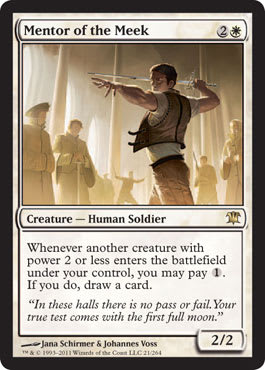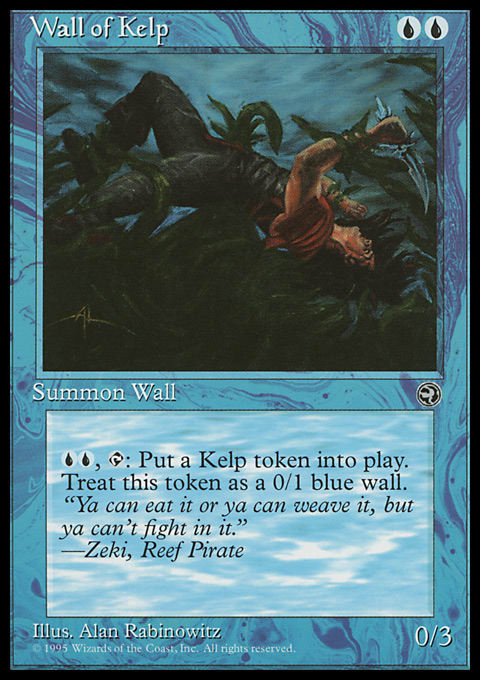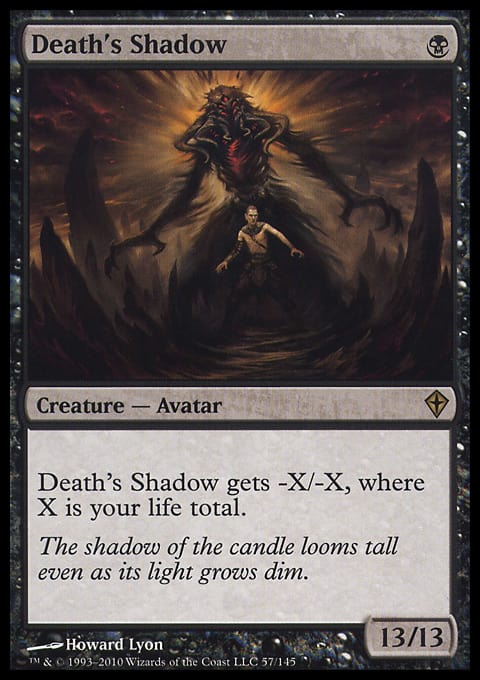Zugzwang is primarily a chess term, meaning “in-between move” and borrowed pretty obviously from German. It refers to a board state that would be fine for your opponent except for that annoying need to make a move. The defenses are perfectly constructed, but the opponent can’t just pass the turn, and if you’ve successfully put zugzwang on the opponent, that player’s necessity to move is his or her undoing.
There isn’t a perfect zugzwang analog in Magic, but there are some derived principles that make intriguing decks. It’s great to achieve in chess; let’s see how worthwhile it is in Magic.
Where Zugzwang Can Show Up
In one sense, zugzwang happens all the time in multiplayer. The rattlesnake effect—placing a disincentive to messing with you—achieves zugzwang relative to certain players. By giving reasons to attack somebody else, you’re encouraging them to pass the turn relative to you. Now, with the right deck construction, they can’t ignore you forever, but they can hope that someone else deals with you in the meantime.
In another sense, true zugzwang is unattainable apart from the normally slight pressure of running out of cards in your library. Most cards that forcibly break a stalled board are subpar (Chemister's Trick?), so you’re mainly looking for decks that strongly encourage a move with inevitability—the closest thing you can get to forcing—but are difficult to attack profitably. I’m going to throw up some random decks that have played out this way so you can get the idea. Where I think this might be helpful in particular is that as a concept obvious to chess but not Magic, seeing how these decks work might inspire you in breaking difficult cards.
"Standard White Weenie"
- Creatures (37)
- 3 Attended Knight
- 3 Mentor of the Meek
- 3 Restoration Angel
- 4 Ajani's Sunstriker
- 4 Angel of Jubilation
- 4 Elite Inquisitor
- 4 Fiend Hunter
- 4 Precinct Captain
- 4 Odric, Master Tactician
- 4 Thalia, Guardian of Thraben
- Lands (23)
- 23 Plains
In the small testing I’ve done, this or something close to it has Friday Night Magic potential—despite it looking amateurish. (If you’re going that route, consider Intrepid Hero, Slayer of the Wicked, Seraph of Dawn, and Safe Passage/Rootborn Defenses/Faith's Reward for the sideboard.) Its success made little sense to me until I realized how it could control either side of tempo.
With an endless stream of aggressive 2-drops and midgame flyers, the deck has no problems with combat, especially with nineteen first strikers. The deck’s offensive capabilities are clear. But what this white weenie deck does better than its peers is run a long game, thanks to all that first strike. A mess of first strike makes counterattacks difficult, at which point Mentor of the Meek’s card advantage takes over. As long as Mentor of the Meek is doing its thing, the opponent’s passing the turn helps you and hurts him. He has bigger creatures than yours and therefore is sort of okay with passing the turn—not true of chess zugzwang—but he has to beat Mentor of the Meek, and having three or four 2/X first strikers says he can’t beat it in combat.
Mentor of the Meek provides that inevitability primarily by drawing into Odric, Master Tactician. Not does Odric serve as more first strike until you can swing profitably, but it obviates all creature defenses. Pick some creatures you want to get through—Precinct Captain’s a good one since it will provide a chump-blocker—leave enough first strike up to block, and the game’s yours.
So, that’s one way you can force an opponent into a situation from which he has to move but every move is bad. On the complete other end of the deck spectrum, there’s the deck that (almost) never attacks:
"Another Glyph in the Wall"
- Creatures (24)
- 2 Aether Membrane
- 2 Djinn Illuminatus
- 2 Echo Mage
- 2 Fog Bank
- 2 Izzet Guildmage
- 3 Mnemonic Wall
- 3 Wall of Earth
- 4 Vent Sentinel
- 4 Wall of Kelp
- Spells (12)
- 4 Fling
- 4 Glyph of Destruction
- 4 Surreal Memoir
- Lands (24)
- 12 Island
- 8 Mountain
- 4 Izzet Guildgate
The combo of Glyph of Destruction and Fling is far from original with me, but it’s hilarious to build around regardless. For this recipe, all you need are both instants and a willing Wall, and you can throw 10 damage at the nearest face. Where I attempt to go over the top is to make sure I’m dealing 20 damage every time by copying the Glyph and/or the Fling (if you get the “and,” you can kill multiple opponents). The non-defenders are there for copying, while Surreal Memoir and Mnemonic Wall return combo pieces.
So, how does this, a deck whose creatures combine for 22 power, bring fresh-baked zugzwang to the opponent? The answer is the non-Wall defender Vent Sentinel. Homelands gem Wall of Kelp makes Plant Wall tokens named Kelp, so each Kelp adds to Vent Sentinel’s damage. For every turn you’re not attacked, you can make additional Kelp, and it doesn’t take many before Vent Sentinel hits hard.
That’s the inevitability. Before Vent Sentinel, the only threat you represent is the cards in your hand. If an opponent attacks you, he might die to your combo, and it’s not worth swinging at a Wall of Earth anyway. In my view of multiplayer, decks that require a lot of explanation are targeted, not necessarily for power level, but because the deck’s controller is taking up a disproportionate amount of time, thereby attracting notice. “It’s still his turn?” is the path to much despair. This deck has no such problems and therefore can go under the radar for surprisingly long.
But there’s a point at which the opponents have to notice, usually if you’re the last one to finish off. And at that point, you just might be hitting with Vent Sentinel while holding enough cards to make every attack dangerous. If the opponent does nothing, Vent Sentinel kills him. If the opponent attacks, Glyph of Destruction/Fling kills him. That’s exactly what we’re looking for—there’s nowhere to go but down.
Last but not least, we have one of my favorite decks. It isn’t meant for multiplayer greater than three players, but it can rule a small game.
"The Other Delver"
- Creatures (9)
- 2 Phyrexian Delver
- 3 Death's Shadow
- 4 Vampire Lacerator
- Spells (28)
- 4 Traitor's Clutch
- 2 Beseech the Queen
- 3 Infernal Contract
- 4 Dead Reckoning
- 4 Rite of Consumption
- 4 Sign in Blood
- 3 Blessing of Leeches
- 4 Pestilence
- Lands (23)
- 23 Swamp
The entire deck’s built around Death's Shadow. Thanks to seven card-draw spells, the deck’s game plan is remarkably consistent: Use some combination of Vampire Lacerator, Sign in Blood, and Infernal Contract to drop your life low (and hope to discard a Traitor's Clutch at some point) and find Death's Shadow. Once Death's Shadow is large and in charge, give it shadow from Traitor's Clutch, swing, and cast Rite of Consumption on the second main phase for the win, using Pestilence to fill in the gaps.
To go through each support spell in more detail:
Vampire Lacerator is an early source of damage that takes the pressure off the rest of the deck while naturally paving the way for Death's Shadow. Phyrexian Delver has only the Vampire and the Shadow to return, so its life loss doesn’t hurt too much, but even if it does, you’re just pumping your best creature. Pestilence clears the board, deals damage as a warm up for Death's Shadow, and pumps Death's Shadow; it’s fantastic here, just as it is in several decks. Blessing of Leeches protects Death's Shadow and pumps it; I’m not sure there’s another deck that wants the card, but it’s fine here.
Blessing of Leeches and Phyrexian Delver team with Dead Reckoning to rebuy your Death's Shadow should someone deal with it. Dead Reckoning also deals 13 damage with Death's Shadow, so it can remove most things. Infernal Contract always feels risky, but it digs far deeper in your deck than turn three normally gets to, usually giving you enough cards in your hand to discard Traitor's Clutch, which is crucial both for pushing damage through and for a slight pump to Rite of Consumption. (As a bonus, sacrificing Death's Shadow to Rite of Consumption takes you to 13 every time, saving you valuable math.) Beseech the Queen can find pretty much any card in the deck on turn three. That’s usually Death's Shadow, but it could be Rite of Consumption as well.
The text might not give a sense of how this plays out. Here’s a pretty normal turn sequence:
Turn one: Swamp, Vampire Lacerator
Turn two: Swamp, Sign in Blood, attack with Vampire Lacerator (you’re at 17; opponent’s at 18)
Turn three: Swamp, Infernal Contract, attack with Vampire Lacerator, discard Traitor's Clutch (8 to 16)
Turn four: Death's Shadow, attack with Vampire Lacerator (7 to 14; Death's Shadow is a 6/6)
Turn five: Flash back Traitor's Clutch to give the Shadow shadow, swing for 8 (it’s naturally a 7/7 since you lost life to Vampire Lacerator), Rite of Consumption Death's Shadow for the final points
It’s an aggro-combo deck, but it’s far more consistent than it ought to be because of all the card-draw. I showed an ideal five-turn sequence, but an approximation of it is much more likely to happen with this deck than similar decks because of all the card-draw. It’s a lot easier to find your combo pieces when part of the combo is drawing six extra cards.
So, where does zugzwang come in? Well, unlike almost every other deck that’s ever existed, losing life is part of your game plan. If you have Death's Shadow stuck in your hand, you welcome an attack. After opponents figure out what you’re doing, they don’t want to attack you for fear they’ll enable your deck. They start trying to kill Vampire Lacerator not because it’s highly aggressive, but because it’s causing you to lose life. Like with the Wall deck, opponents don’t want to attack you, but they can’t pass the turn too often for fear you’ll find the combo anyway.
If you want to put the deck together to see what I mean, it costs all of about $8. But it’s as frightening to face as it is to play, turning tempo upside-down for your benefit.
Conclusion
It might not be what they mean in chess, but you can force opponents into strange situations where they’re scared to attack but have to make some sort of move. If the above decks are representative, the way to mess with this area of tempo is through combat. Passing the turn’s normally okay with chump-blockers out; Odric, Vent Sentinel, and Death's Shadow with shadow say in different ways that chump-blockers just don’t matter, meaning their only use is as bad attackers.
Just as importantly, for what these decks to “regular” Magic, they’re loads of fun. Try a deck like this for yourself and see how you like it. If nothing else, think about how you pressure opponents in a typical game and see if you can change up your typical pressure points. You can keep many an opponent off-balance if he doesn’t know your angle of attack. Besides, you get to say zugzwang a lot. That can’t be all bad.

























